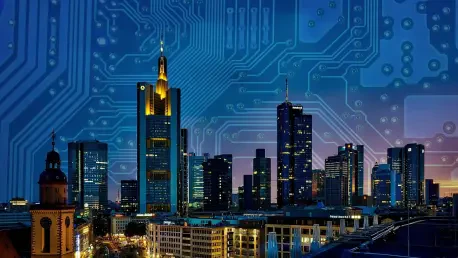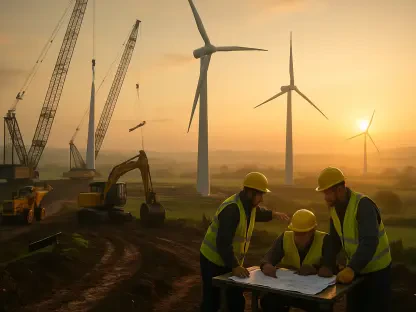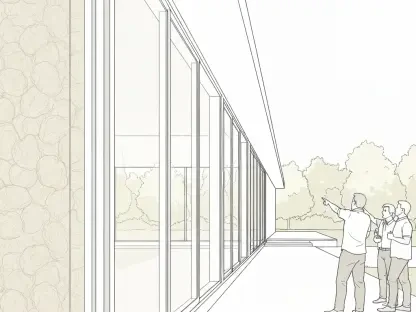In recent years, advancements in technology have profoundly changed the way urban environments are conceived and experienced, with smart buildings at the forefront of this transformation. Modern urban architecture is moving away from static, traditional structures towards dynamic, intelligent systems that are capable of anticipating and adapting to the needs of their occupants. This shift has been driven largely by the integration of cutting-edge technologies such as Artificial Intelligence (AI), the Internet of Things (IoT), and edge computing, which collectively bolster the functionality and sustainability of urban living spaces. By enhancing the efficiency and comfort of cities while reducing environmental impact, smart buildings are laying the groundwork for a revolutionary era in urban living.
Evolving Building Dynamics
From Static Structures to Intelligent Systems
Buildings, once seen as inanimate entities, are progressively taking on a new identity as proactive and predictive systems, thanks to technological innovation. With AI and IoT at the helm, these structures are not merely passive environments but are equipped to analyze real-time data and react accordingly. This capability allows them to adjust to ongoing changes in occupancy, weather conditions, and behavioral patterns, greatly enhancing user experience. These technologies enable buildings to autonomously regulate heating, ventilation, and air conditioning, maintaining comfortable spaces with remarkable energy efficiency. This directional shift has led to a cultural transformation in how both developers and occupants perceive and interact with architectural spaces, as they strive for environments that not only consume fewer resources but also adapt intelligently to their surroundings.
Advancements in Energy Optimization
One of the most significant developments within smart building technology is the optimization of energy use. IoT devices play a pivotal role in this domain by acting as the sensory pathways that gather data on energy consumption, CO₂ levels, light, and movement. With edge computing ensuring swift data processing, buildings make instant decisions about energy deployment. This method not only bolsters system efficiency but also enhances privacy as data processing stays localized. Moreover, the shift toward net-zero buildings is underscored by features such as smart lighting, automated energy management, and integration with renewable energy sources. By feeding excess energy back into the grid, smart buildings not only become self-sufficient but contribute to the broader urban energy landscape. These advancements represent a leap toward sustainable living as urban environments seek to lower their carbon footprints.
Enhancing Urban Resilience and Comfort
Strengthening Security and Privacy
The enhanced capability of intelligent infrastructure significantly boosts building resilience and security, factors that are crucial in today’s interconnected urban contexts. AI-driven security systems, employing technologies like facial recognition and anomaly detection, ensure that sensitive areas within buildings remain accessible only to authorized individuals. Additionally, integrated safety systems combine functionalities such as air quality monitoring, fire alarms, and leak detection, forming cohesive networks that can predict and respond rapidly to emergencies. Data protection is indispensable in maintaining stakeholder trust, with buildings adopting secure protocols, encryption, and redundancies. These measures collectively create a solid framework for safeguarding both physical and digital realms within smart buildings, making them secure hubs in the ever-expanding urban landscape.
Elevated Living Experiences
Smart buildings not only aim for operational efficiency but also aspire to elevate quality of life, contributing to overall well-being and productivity. With intelligent lighting systems that sync with natural circadian rhythms and climate control systems that maintain optimal humidity and temperature levels, smart environments are designed to be conducive to stress reduction. For residential settings, these technologies intertwine with daily life, offering conveniences such as voice-controlled functionalities and app-based guest access. These features not only enrich the living experience but support a human-centric approach to architectural design. As urban populations grow, such thoughtful implementations in smart buildings ensure that livability remains a priority, enhancing the human connection to the spaces they inhabit.
The Road Ahead for Smart Cities
Building Networks as Foundations
The concept of smart cities is inseparable from the smart buildings that constitute them. These structures, by exchanging data with municipal systems, participating in grid-wide energy balancing, and efficiently utilizing infrastructure, serve as catalysts for urban transformation. In this emergent urban model, buildings are envisioned not as isolated entities but as integral participants in a broader ecosystem. This interconnected approach helps create cities that are more responsive to inhabitants’ needs while facilitating better resource management. The symbiosis between building networks and municipal services offers a path toward cities that are adaptive and future-ready, setting the stage for continuous evolution in urban living.
Continuous Evolution in Urban Life
As technologies continue their rapid evolution, smart buildings constantly learn and improve, furthering their roles within urban settings. The ability to identify patterns and predict needs enables adaptive management of energy loads and maintenance schedules, extending equipment lifecycles while simultaneously reducing costs. By creating spaces that evolve in tandem with user requirements, smart buildings directly enhance investment opportunities for developers and foster improved occupancy experiences. As increasing urbanization highlights the need for adaptable and sustainable infrastructures, the continuous learning and integration seen in smart buildings signal a forward-reaching approach to city planning and development.
A Future Shaped by Intelligent Design
The idea of smart cities is intrinsically linked to the smart buildings that form their core. These innovative structures are not simply independent units; rather, they actively communicate with city-wide systems, play a role in energy distribution across grids, and optimize the use of resources and infrastructure. This interaction is pivotal for transforming urban spaces. In the evolving model of urbanization, buildings aren’t viewed as solitary constructs but as key components of an extensive network, leading to cities that are more aligned with the needs of their residents. This integration facilitates enhanced management of resources, promoting an environment that is reactive to the inhabitants’ demands. The relationship between building networks and city services paves the way for cities that are adaptable and ready for the future. This lays the groundwork for continuous innovation and progression in how urban areas are developed and lived in, promising to cater to ever-changing human and environmental requirements.









